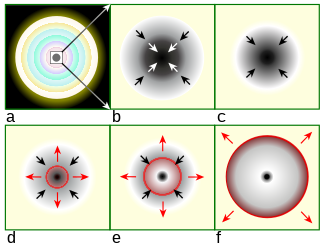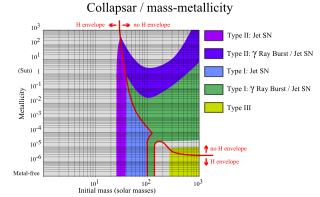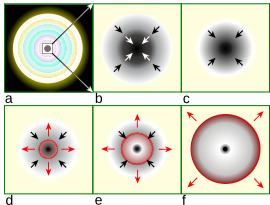Related Research Articles

A black hole is a region of spacetime where gravity is so strong that nothing, including light and other electromagnetic waves, has enough energy to escape it. The theory of general relativity predicts that a sufficiently compact mass can deform spacetime to form a black hole. The boundary of no escape is called the event horizon. Although it has a great effect on the fate and circumstances of an object crossing it, it has no locally detectable features according to general relativity. In many ways, a black hole acts like an ideal black body, as it reflects no light. Moreover, quantum field theory in curved spacetime predicts that event horizons emit Hawking radiation, with the same spectrum as a black body of a temperature inversely proportional to its mass. This temperature is of the order of billionths of a kelvin for stellar black holes, making it essentially impossible to observe directly.
The Chandrasekhar limit is the maximum mass of a stable white dwarf star. The currently accepted value of the Chandrasekhar limit is about 1.4 M☉ (2.765×1030 kg).

A neutron star is the collapsed core of a massive supergiant star, which had a total mass of between 10 and 25 solar masses (M☉), possibly more if the star was especially metal-rich. Except for black holes, neutron stars are the smallest and densest known class of stellar objects. Neutron stars have a radius on the order of 10 kilometers (6 mi) and a mass of about 1.4 M☉. They result from the supernova explosion of a massive star, combined with gravitational collapse, that compresses the core past white dwarf star density to that of atomic nuclei.

Stellar evolution is the process by which a star changes over the course of time. Depending on the mass of the star, its lifetime can range from a few million years for the most massive to trillions of years for the least massive, which is considerably longer than the current age of the universe. The table shows the lifetimes of stars as a function of their masses. All stars are formed from collapsing clouds of gas and dust, often called nebulae or molecular clouds. Over the course of millions of years, these protostars settle down into a state of equilibrium, becoming what is known as a main-sequence star.
Degenerate matter occurs when the Pauli exclusion principle significantly alters a state of matter at low temperature. The term is used in astrophysics to refer to dense stellar objects such as white dwarfs and neutron stars, where thermal pressure alone is not enough to avoid gravitational collapse. The term also applies to metals in the Fermi gas approximation.
In astronomy, the term compact star refers collectively to white dwarfs, neutron stars, and black holes. It would grow to include exotic stars if such hypothetical, dense bodies are confirmed to exist. All compact objects have a high mass relative to their radius, giving them a very high density, compared to ordinary atomic matter.
A gravastar is an object hypothesized in astrophysics by Pawel O. Mazur and Emil Mottola as an alternative to the black hole theory. It has usual black hole metric outside of the horizon, but de Sitter metric inside. On the horizon there is a thin shell of matter. The term "gravastar" is a portmanteau of the words "gravitational vacuum star".

A stellar black hole is a black hole formed by the gravitational collapse of a star. They have masses ranging from about 5 to several tens of solar masses. The process is observed as a hypernova explosion or as a gamma ray burst. These black holes are also referred to as collapsars.

Gravitational collapse is the contraction of an astronomical object due to the influence of its own gravity, which tends to draw matter inward toward the center of gravity. Gravitational collapse is a fundamental mechanism for structure formation in the universe. Over time an initial, relatively smooth distribution of matter will collapse to form pockets of higher density, typically creating a hierarchy of condensed structures such as clusters of galaxies, stellar groups, stars and planets.

The surface gravity, g, of an astronomical object is the gravitational acceleration experienced at its surface at the equator, including the effects of rotation. The surface gravity may be thought of as the acceleration due to gravity experienced by a hypothetical test particle which is very close to the object's surface and which, in order not to disturb the system, has negligible mass. For objects where the surface is deep in the atmosphere and the radius not known, the surface gravity is given at the 1 bar pressure level in the atmosphere.

A collapsar is a star which has undergone gravitational collapse. When a star no longer has enough fuel for significant fusion reactions, there are three possible outcomes, depending on the star's mass: If it is less than the Chandrasekhar limit, the star will stabilize and shrink, becoming a white dwarf; between the Chandrasekhar limit and the Tolman–Oppenheimer–Volkoff limit, it will become a neutron star; and above the Tolman–Oppenheimer–Volkoff limit, the star will become a black hole. However, it is theorized that the high density of neutron star cores allow for quark matter and, as a result, a star that is more massive than even the Tolman–Oppenheimer–Volkoff limit, yet still isn't a black hole.

The following outline is provided as an overview of and topical guide to astronomy:
The Tolman–Oppenheimer–Volkoff limit is an upper bound to the mass of cold, non-rotating neutron stars, analogous to the Chandrasekhar limit for white dwarf stars. If the mass of a neutron star reaches the limit it will collapse to a denser form, most likely a black hole.
In astrophysics, the Tolman–Oppenheimer–Volkoff (TOV) equation constrains the structure of a spherically symmetric body of isotropic material which is in static gravitational equilibrium, as modelled by general relativity. The equation is

Gamma-ray burst progenitors are the types of celestial objects that can emit gamma-ray bursts (GRBs). GRBs show an extraordinary degree of diversity. They can last anywhere from a fraction of a second to many minutes. Bursts could have a single profile or oscillate wildly up and down in intensity, and their spectra are highly variable unlike other objects in space. The near complete lack of observational constraint led to a profusion of theories, including evaporating black holes, magnetic flares on white dwarfs, accretion of matter onto neutron stars, antimatter accretion, supernovae, hypernovae, and rapid extraction of rotational energy from supermassive black holes, among others.
The following outline is provided as an overview of and topical guide to black holes:
In astrophysics, an event horizon is a boundary beyond which events cannot affect an observer. Wolfgang Rindler coined the term in the 1950s.

A neutron star merger is a type of stellar collision.
In general relativity, the Oppenheimer–Snyder model is a solution to the Einstein field equations based on the Schwarszschild metric describing the collapse of an object of extreme mass into a black hole. It is named after physicists J. Robert Oppenheimer and Hartland Snyder, who first described the model in 1939.
References
- ↑ Marshall, Trevor (2016). "The Shell Collapsar—A Possible Alternative to Black Holes". Entropy. 18 (10): 363. Bibcode:2016Entrp..18..363M. doi: 10.3390/e18100363 .
- ↑ Marshall, Trevor. "Neutron stars beyond the TOV limit" . Retrieved 2019-12-21.
- ↑ Mitra, Abhas (2013). "The Mass of the Oppenheimer–Snyder-Black Hole: Only Finite Mass Quasi-Black Holes". International Journal of Modern Physics D. 22 (9): 1350054. doi:10.1142/S0218271813500545.
- ↑ Zakir, Zahid (2007). "General relativity constrains proper times and predicts frozen stars instead of black holes". Theoretical Physics, Astrophysics and Cosmology: 1–8. arXiv: 0705.2585 . doi:10.9751/TPAC.2497-006.
- ↑ Zakir, Zahid (2018). "On the consistency of the Oppenheimer-Snyder solution for a dust star. Reply to Marshall's criticism". Astrophysics and Space Science. 363 (2): 30. Bibcode:2018Ap&SS.363...30Z. doi:10.1007/s10509-018-3246-9.
- ↑ Marshall, Trevor W. "Supermassive neutron-star mergers as source of the gravitational wave events" . Retrieved 2019-12-21.
